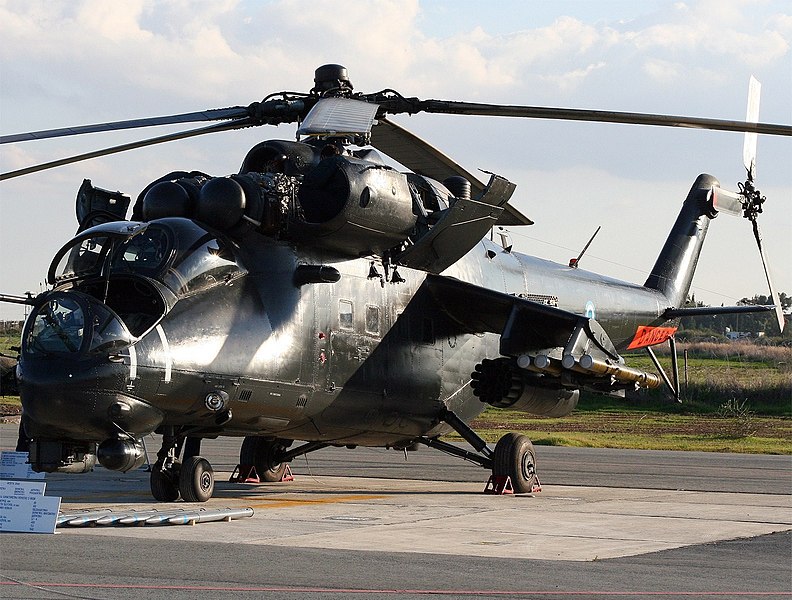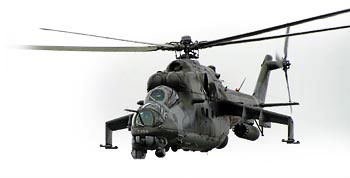Talks for Russian Mi-35 copters at final stages
(It was 2003, then what happen ?)
Aroosa Alam
Islamabad—With the final batch of four Mi-171 military helicopters produced at a plant in the Siberian Republic of Buryatia to be delivered to Pakistan later this year, Moscow and Islamabad are at the final stages of negotiating another deal of attack/transport helicopter Mi-35P, the improved version of Mi-24 for Pakistan’s first Air Assault Division, well placed defence sources told Pakistan Observer.
The ongoing negotiations between the two countries were also confirmed by highly placed Russian sources in Islamabad who further indicated that the two countries may also look into acquisition of Russian Ka-32 all purpose helicopter which can carry cargo upto 5 tons on outer suspension and can be used for rescue operations, servicing oil and gas pipeline and construction work. Russian sources said that the ongoing defence cooperation talks are part of restored Pak-Russian relations under the changed global strategic and political situation. Pakistan’s greater role in war against terrorism and its very positive policy towards Chechnya has led to the change of Russian defence policy towards Pakistan.
Sources said that Russian Director General, South Asia, will be visiting Pakistan during the month of Ramazan to discuss a variety of issues between the two countries which will also include bilateral defence cooperation. This will be followed up by the Russian Deputy Foreign Minister’s visit in December this year. Pakistani Foreign Minister Khurshid Mehmud Kasuri will visit Moscow in the first half of next year to follow up progress on President General Pervez Musharraf’s visit which took place in February this year.
Prior to President Musharraf’s visit to Moscow, the Russian President as a goodwill gesture approved a deal between the two countries for the sale of 12 Mi-171 military helicopters, first deal in last six years. In 1996, Islamabad bought a dozen of Mi-17 transport choppers. The Mi-171 are military transport helicopters with high precision controlled and non-controlled armament.
Pakistan after assessing Indian heli-borne capabilities has been striving to raise Air Assault Division by inducting new systems into its inventory. Following painstaking negotiations, Pakistan and Russia are reported to be close to a deal to acquire Mi-24/Mi-35 NATO code name Hind.
The Mi-24 attack/transport helicopter is manufactured by the Mil Moscow Helicopter Plant, based in Moscow. It has been deployed in a number of conflicts including Afghanistan and in Chechnya. The original model (NATO code name Hind-A), designed to carry eight combat troops, was later reconfigured to take on the gunship role (Hind-D). Later versions, Mi-24P and the export Mi-35P, are also armed with anti-tank missile systems for the engagement of moving armoured targets, weapon emplacements and slow-moving air targets. All versions retain the troop transport capability.
Russian Army Mi-24s are being upgraded with new avionics including thermal imagers. The ‘Visegrad Four’ (Czech Republic, Hungary, Poland and Slovakia) signed an agreement in February 2003 to jointly upgrade up to 105 Mi-24D/V helicopters to NATO standards. This agreement has been abandoned. Companies expected to submit tenders include: ATE (South Africa), BAE Systems (UK), Elbit (Israel), Eurocopter (France/Germany), IAI Tamam (Israel) and Sagem (France).
The helicopter has six suspension weapon units on the wingtips. The Mi-24D (Mi-25) and the Mi-24V (Mi-35) are equipped with a YakB four-barrelled, 12.7mm, built-in, flexibly mounted machine-gun, which has a firing rate of 4,000-4,500 rounds per minute and a muzzle velocity of 860m/s. The Mi-24P is fitted with a 30mm, built-in, fixed gun mount; the Mi-24VP with a 23mm, built-in, flexibly mounted gun.
The Mi-24P and Mi-24V have four underwing pylons for up to twelve antitank missiles. The Mi-24V (Mi-35) is armed with the Shturm anti-tank guided missile system. Shturm (NATO designation AT-6 Spiral) is a short-range missile with semi-automatic radio command guidance. The 5.4kg high-explosive fragmentation warhead is capable of penetrating up to 650mm of armour. Maximum range is 5km.
The Mi-24V can also carry the longer-range Ataka anti-tank missile system (NATO designation AT-9), as can the Mi-24P. The Ataka missile’s guidance is by narrow radar beam, and the maximum range of the missile is 8km. The average target range is between 3-6km. The target hit probability of the Ataka missile is higher than 0.96 at ranges 3-6km. The missile has a shaped-charge 7.4kg warhead, with a tandem charge for penetration of 800mm thick explosive reactive armour. All Mi-24 helicopters can also be armed with rockets and grenade launchers. The Mi-24D is equipped with the KPS-53A electro-optical sighting pod. The most recent Mi-24V and P variants have a digital PNK-24 avionics suite and multifunction LCD cockpit displays, and Geofizika ONV1 night-vision goggles, along with NVG-compatible cockpit lighting. They are fitted with the Urals Optical and Mechanical Plant GOES-342 TV/FLIR sighting system and a laser rangefinder. Countermeasures include infrared jammer, radar warner and flare dispensers.
According to Pakistan’s assessment Indian are quite capable of carrying out para-heliborne operations in the combat zone in all types of terrain, however, they don’t possess the capability to conduct heli-borne operations in Pakistan’s communication zones. Pakistan’s security planners are recommending to the government to form a heliborn force which is equitable with Indian capabilities in this field. Inspired by the US idea of Rapid Deployment Force, Indians have redefined the role of heli-borne forces. Pakistan is also contemplating to re-define its forces accordingly. Acquistion of Russian Mi-24/ Mi-35 is part of Pakistan’s redefined military strategy.
India can hel-lift up to Brigade of Air Assault Division. Indians have a para-Brigade, three para-commandos battalions, six para/battalions and two para-Artillery regiments. It has 70 Mi-8, 90 Cheetak, 48 MI-17 and 8 MI-26 helicopters that come to 216 total with additional 140 fixed wing aircraft.
Pakistan’s choice to acquire MI-24/Mi-35 type helicopters is also due to its historical affiliation with French equipment with a particular reference to close partnership between PAF and SAGEM of France. It may be mentioned here that Russian Rosoboronexport State Corporation and SAGEM entered into a joint venture in June this year for the joint helicopter upgrade project.
Russian and French specialists intend to join efforts in proposing the up-gradation of on-board avionics and armament of Mi-24/Mi-35 type helicopters for the foreign customers.
High-profiled Russian and French state agencies, precisely Military-Technical Co-operation Committee of Russia (KVTS) and Delegation General pour l’Armement of France (DGA), provide political and military technical support to this joint project. If an agreement reaches, Pakistan can expect from both Russia and France a flexible policy of payment for the upgradation of Mi-35 helicopters. Both sides have indicated different financing schemes including usage of capabilities of the states.










